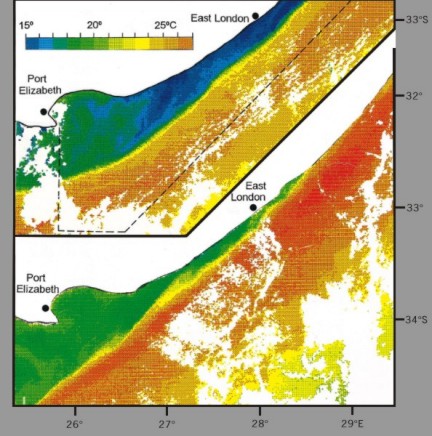Port Alfred Upwelling Cell
Dowload the PDF of this lesson by clicking here
 |
Along the eastern extremes of the Agulhas Bank, between East London and Port Elizabeth, the continental shelf starts widening. It has been shown that frequent, substantial shelf edge upwelling occurs here (refer to Fig. 1). Lutjeharms et al. (2000) showed the clear delimitation of a surface upwelling cell (an entirely localised phenomenon). It is thought that this upwelling is caused by the divergence of the Agulhas Current from the coast. The core of the cell is found at Port Alfred. Upwelling in this region contributes a high nutrient load to the far eastern Agulhas Bank (refer to Fig. 2). This cell is fed by water upwelled from Central Water depths. (Lutjeharms et al., 2000) |
|
Figure 1 |
 |
A recurrent process of surface outcropping of this upwelled water has been shown by the use of thermal infrared imagery. Local wind action is believed to bring this already upwelled at depth water to the sea surface. This upwelling cell is only intermittently detectable at the sea surface when this outcropping occurs. (Lutjeharms et al., 2000) |
|
Figure 2 |
CLASSIC PAPER
Lutjeharms, J. R. E., Cooper, J. and Roberts, M. (2000). Upwelling at the inshore edge of the Agulhas Current. Continental Shelf Research, 20, 737-761.



